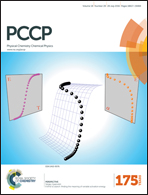Bifurcate localization modes of excess electron in aqueous Ca2+⋯amide solution revealed by ab initio molecular dynamics simulation: towards hydrated electron versus hydrated amide anion†
Abstract
In this work, we conduct ab initio molecular dynamics simulations on the localization dynamics of an excess electron (EE) in acetamide/Ca2+ aqueous solutions with three different interaction modes of Ca2+ with acetamide: tight contact, solvent-shared state, and separated interaction. The simulated results reveal that an EE could exhibit two different localization behaviors in these acetamide/Ca2+ aqueous solutions depending on different amide⋯Ca2+ interactions featuring different contact distances. For the tight contact and solvent-shared state of amide⋯Ca2+ solutions, vertically injected diffuse EEs follow different mechanisms with different dynamics, forming a cavity-shaped hydrated electron or a hydrated amide anion, respectively. Meanwhile, for the separated state, only one localization pattern of a vertically injected diffuse EE towards the formation of hydrated amide anion is observed. The hindrance of hydrated Ca2+ and the attraction of the hydrated amide group originating from its polarity and low energy π* orbital are the main driving forces. Additionally, different EE localization modes have different effects on the interaction between the amide group and Ca2+ in turn. This work provides an important basis for further understanding the mechanisms and dynamics of localizations/transfers of radiation-produced EEs and associated EE-induced lesions and damage to biological species in real biological environments or other aqueous solutions.


 Please wait while we load your content...
Please wait while we load your content...